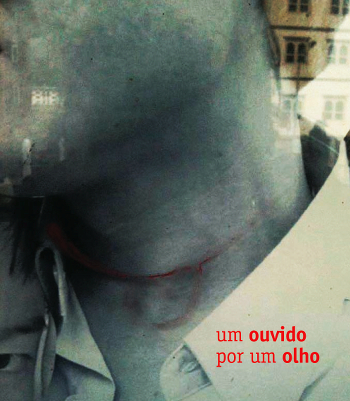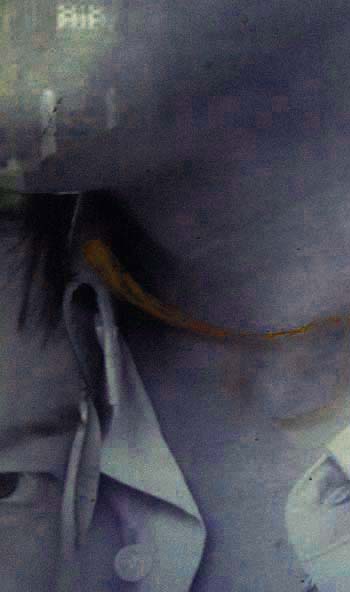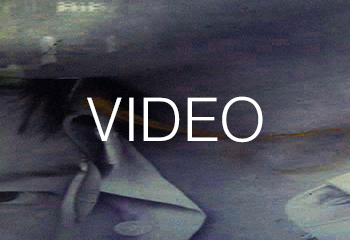
[deutsch]
an ear for an eye
"...but all that radio is, Morty,
is making audible to your ears
what was already in the air and available to your ears,
but you couldn't hear it...
In other words, all it is which you're already in.
You are bathed in radio waves".John Cage
conversation with Morton Feldman
1966-67
You may not know it but well before you could do anything else you were already listening. At four and a half months the bath of sound began right there, inside that belly in which you grew receiving her voice, or her heart beating, her bowels at work ...when your mother breathed, laughed, swallowed, wept ....you listened. Long before you saw anything, or tasted anything or discerned color... because everything floated, touch was also unlikely. There was nothing but sound.
Then you came out of that sound bath: you were born.
Walter Murch reminds us that quickly and instantly all of the other senses come into play and sounds lose importance.
In fact, the separation between sound and image in our life experience doesn't exist (unless there is a physical impediment). It is very hard to imagine an absolutely deaf and dumb universe, or world. Even while locked inside a completely soundproofed chamber - John Cage proved it - we end up listening to our heartbeats, blood flowing through our arteries, not to mention our noisy breathing. Not by chance, various artists during the second half of the twentieth century became interested in integrating visual works with sounds. But even before then other arts had worked with image and sound - cinema, to say the least.
That eye has teeth
That eye has a tongue
That eye speaks.
A point in space may be equidistant. It is a question of determining this space: the glass of an empty aquarium, an aquarium that is a sound studio... the distance between the sound and the skull plugged directly into a head phone ... the point between your ears or only the distance between your ears? The cerebral hemispheres alternate tasks of intelligence. Specific qualities are ascribed to each side of the brain - right or left. But in order to listen, it is enough that the waves flood your ringing ears. There is no dearth of devices that amplify this experience, leading the act of listening to multiply within the complex space between our ears. Then, someone turns on or clicks that button in the age of digital media when the concept of what we have come to understand as "radio" is being speedily demolished in the lacunae and in the homogenization of globalized media practices. Ok: a great revolution. Another one... and again the standard threat: radio is going to die. Current signs of the dissolution of the centralization of mass media such as virtual, independent, personal, interactive broadcasters, represent significant changes in radio tradition, casting light upon centennial ideas such as the suggested message of radio pioneers Fessenden and De Forest to "broadcast yourself" - currently the slogan of YouTube.
These are but a few steps in the dance but no one appears to give up the perspective that has already proven itself periodically faulty, perhaps because this time it already outlines some mutating aesthetic difference on the horizon: in multimedia radio has images - and not just sound images.
Propositions the not always well-defined boundaries of which evolve in counterpoint to the dialogue between artists and theorists when they perceive the art of independent radio encounters new possibilities. Yes, rather than a threat, it stands as a stimulating challenge for another reinvention of radio.
The matter of the image in radio
We need not detain ourselves over the possibilities of the image, we should like only to point out two initial perceptions: the image that is already sound in itself, like the one in which soap bubbles burst; or a windstorm, or someone speaking secretly. In seeing, we immediately hear something imagined.

Images that suggest listening in their references are even more indirect. As we look at the feet in Botticelli's Allegory of Spring, our memory is led back through the history of painting even as it follows new footsteps that hear galena crystals falling upon those same feet. Thus, the "image of radio" is formed by a series of references that include the histories of audio and visuality.
It is worth recalling the impact of Jean Négroni's voice in Chris Marker's 1962 film La Jetée. By assembling photographs, Marker builds his filmic narrative upon the confessional voice of Negróni, who later said "I had the deep, hurried voice of a narrator". An inner voice like those of so many radio speeches define so well. Similar to that confessional voice, in Blue (his last film), Derek Jarman offers nothing less than blue on the flat screen and the reflections of that voice. Readings that allude to sight, as in Godard's Nouvelle Vague, in which Alain Delon continuously soliloquizes in a voice redolent of radio to so many. Other propositions appear as examples, not all of them precise, although the ones that propose to "see music" through animation or cartoons should be remembered.
Germanos Celant recalls that the interaction between art and sound is interwoven throughout the entire history of art from the 17th to the 21st centuries, aspiring to investigate sensory pace or territory that does not fit in with the Western tradition or its schematic coordinates. It signals the entire course of modernity and the development of synesthetic relations between different languages of communication, with the purpose of finding another, unconventional order.
But to what point are those images radio?
A language is the place whence one sees the world
and in which the boundaries of our thoughts and feelings
are outlined.
Vergílio Ferreira, Portuguese poet
What closes the eyes?
What opens the ears?
If ears can see, then a "roar" is the lion's speech as it spills into our eyes. Yet the question remains: how to freeze listening in an image? When we watch Gone With the Wind on television or play it on DVD, is it still a film or has it become a video? Is an MP3 file still music? Is a radio that transmits but is not affiliated to any station still radio? Radio outside radio? Radio beyond radio? To produce radio listening could be one way to renew auditory perception, somehow revisiting the image through the orientation of audio. Without losing sight of listening, without losing the purpose of this listening. Yes, a tremendous multimedia challenge and, it seems clear, action still in progress.
One day I will find the right words,
and they will be simple.
Jack Kerouac
Radio can now lead you to visual maps.
words rebuilt...
words deconstructed...
crisscrossed words...
captured voices
voices shared by ears that also see with eyes.
An ear for an eye.
And always someone to ask "is this radio?!"
Radio is reborn.
Along the way, I've brought together works encountered and showcased over the past ten years on my weekly program Rádio Mirabilis, broadcast by Rio de Janeiro's public MEC-FM radio (also via satellite and online). In that radio space I have presented work by these artists: soundscapes and sound art in audio/radio format - which, although it is a potent one, leaves out the visual part of those installations or the photographs and films that accompany the audio. This material (which doesn't yet present itself as radio on a site) is already very much present in places such as facebook, for example. This curator ultimately proposes no thesis; I would like to show part of the Brazilian landscape of propositions of the present and soon-to-be future of radio.
Here is the new challenge: to maintain the determinant aesthetic in radio existence even by adding images to it. To this end, visual inclusion must be done subtly and intelligently lest it be judged as "film", "television", or something that cannot be sustained in light of the very history of images or of radio. That is, when we obtain a radio configuration that interacts powerfully with the visual image, we may well be faced with "visual radio". Trailing this new path - still a work in progress - I came upon the following perception: works made under various "labels" or in diverse "areas" were pursuing possible new forms of radio. According to this path, I have gathered the works. Here are the various artists and propositions I have assembled:
Poet and performer Alex Hamburger; visual artist and visual poet Lenora de Barros; musicians and sound artists Marco Scarassatti, Vivian Caccuri and Thelmo Cristovam; radio artist and radio documentarian Julio de Paula; and musicians Cadu Tenório and Grupo Dedo.
The works of Alex Hamburger and Lenora de Barros refer to the tradition of spoken, written and performed words, exploring sounds and their countless variables. Marco Scarassatti builds his sound sculptures in synchrony with the Brazilian history of sound objects (or "sound sculptures") begun by Walter Smetak. Thelmo Cristovam develops soundscapes in many of his works, whereas Vivian Caccuri explores the relationships between sound phenomena in public spaces.
Artist Cadu Tenório has ties to the electronic and experimental music scenes of Rio de Janeiro; his work is based on field recordings, tape loops, prepared instruments and sounds drawn from everyday objects. The trio of young musicians called Dedo reflects the current trend in pieces that blend music and sound with images (as in the piece "Dash Cam").
